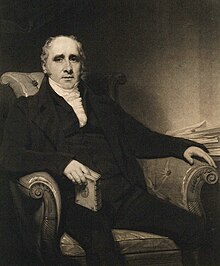Thomas Charles Hope | |
|---|---|
 Thomas Charles Hope, Portrait by Henry Raeburn[1] | |
| Born | 21 July 1766 Edinburgh, Scotland, Kingdom of Great Britain |
| Died | 13 June 1844 (aged 77) Edinburgh, Scotland, United Kingdom of Great Britain and Ireland |
| Nationality | Scottish |
| Alma mater | University of Edinburgh University of Paris |
| Known for | Maximum density of water (Hope's experiment) Discovery of strontium |
| Scientific career | |
| Fields | Chemistry, medicine |
| Institutions | Lecturer in chemistry, University of Glasgow Professor of medicine and chemistry, University of Edinburgh President, Royal College of Physicians of Edinburgh (1815–1819) |
| Thesis | Tentamen inaugurale, quaedam de plantarum motibus et vita complectens (1787) |
| Doctoral advisor | Joseph Black |



Thomas Charles Hope FRSE FRS PRCPE FFPSG(21 July 1766 – 13 June 1844) was a Scottish physician, chemist and lecturer. He proved the existence of the element strontium,[2][3] and gave his name to Hope's Experiment, which shows that water reaches its maximum density at 4 °C (39 °F).[2]
In 1815 Hope was elected as president of the Royal College of Physicians of Edinburgh (1815–19), and as vice-president of Royal Society of Edinburgh (1823–33) during the presidencies of Walter Scott and Thomas Makdougall Brisbane.
Charles Darwin was one of Hope's students, and Darwin viewed his chemistry lectures as highlights in his otherwise largely dull education at the University.[4]
- ^ William Raeburn Andrew (1894). "Appendix, 156 – Hope, Thomas Charles, M.D.". Life of Sir Henry Raeburn, R.A.: With Appendix. W. H. Allen & Company, limited. p. 156. Retrieved 24 July 2017.
- ^ a b Cite error: The named reference
Dictionary of National Biographywas invoked but never defined (see the help page). - ^ Waterston, Charles D; Macmillan Shearer, A (July 2006). Former Fellows of the Royal Society of Edinburgh 1783–2002: Biographical Index (PDF). Vol. I. Edinburgh: The Royal Society of Edinburgh. ISBN 978-0-902198-84-5. Archived from the original (PDF) on 4 October 2006. Retrieved 19 June 2011.
- ^ "Thomas Charles Hope, MD, FRSE, FRS (1766–1844) | School of Chemistry". www.chem.ed.ac.uk. Retrieved 30 April 2021.